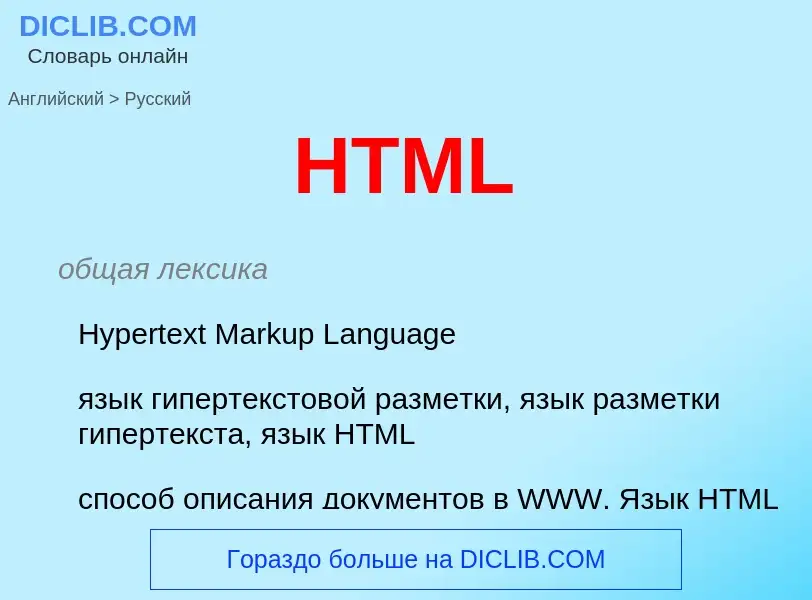ترجمة وتحليل الكلمات عن طريق الذكاء الاصطناعي ChatGPT
في هذه الصفحة يمكنك الحصول على تحليل مفصل لكلمة أو عبارة باستخدام أفضل تقنيات الذكاء الاصطناعي المتوفرة اليوم:
- كيف يتم استخدام الكلمة في اللغة
- تردد الكلمة
- ما إذا كانت الكلمة تستخدم في كثير من الأحيان في اللغة المنطوقة أو المكتوبة
- خيارات الترجمة إلى الروسية أو الإسبانية، على التوالي
- أمثلة على استخدام الكلمة (عدة عبارات مع الترجمة)
- أصل الكلمة
HTML - ترجمة إلى إنجليزي
общая лексика
Hypertext Markup Language
язык гипертекстовой разметки, язык разметки гипертекста, язык HTML
способ описания документов в WWW. Язык HTML использует набор тегов, вводимых в текстовые документы, которые указывают браузеру или другой программе, каким образом информация должна выводится на экран. С помощью тегов в документе могут быть определены (размечены) части, главы, разделы (section), абзацы, списки, рисунки, таблицы, колонтитулы, индекс, содержание и т.д. Внутри каждого блока можно изменять шрифт, размер символов, цвет текста, выделять текст курсивом и/или делать его полужирным. Просмотр HTML-документа осуществляется с помощью браузера. HTML является подмножеством языка SGML, использует чистый ASCII-текст, текущая версия - 4.01 (стандарт на HTML 4.0 принят в декабре 1997 г., а на 4.01 - 24.12.1999 г.), широко применяется для создания страниц WWW
تعريف
ويكيبيديا
The HyperText Markup Language or HTML is the standard markup language for documents designed to be displayed in a web browser. It is often assisted by technologies such as Cascading Style Sheets (CSS) and scripting languages such as JavaScript.
Web browsers receive HTML documents from a web server or from local storage and render the documents into multimedia web pages. HTML describes the structure of a web page semantically and originally included cues for its appearance.
HTML elements are the building blocks of HTML pages. With HTML constructs, images and other objects such as interactive forms may be embedded into the rendered page. HTML provides a means to create structured documents by denoting structural semantics for text such as headings, paragraphs, lists, links, quotes, and other items. HTML elements are delineated by tags, written using angle brackets. Tags such as <img /> and <input /> directly introduce content into the page. Other tags such as <p> and </p> surround and provide information about document text and may include sub-element tags. Browsers do not display the HTML tags but use them to interpret the content of the page.
HTML can embed programs written in a scripting language such as JavaScript, which affects the behavior and content of web pages. The inclusion of CSS defines the look and layout of content. The World Wide Web Consortium (W3C), former maintainer of the HTML and current maintainer of the CSS standards, has encouraged the use of CSS over explicit presentational HTML since 1997. A form of HTML, known as HTML5, is used to display video and audio, primarily using the <canvas> element, together with JavaScript.

![[[Tim Berners-Lee]] in April 2009 [[Tim Berners-Lee]] in April 2009](https://commons.wikimedia.org/wiki/Special:FilePath/Tim Berners-Lee April 2009.jpg?width=200)
